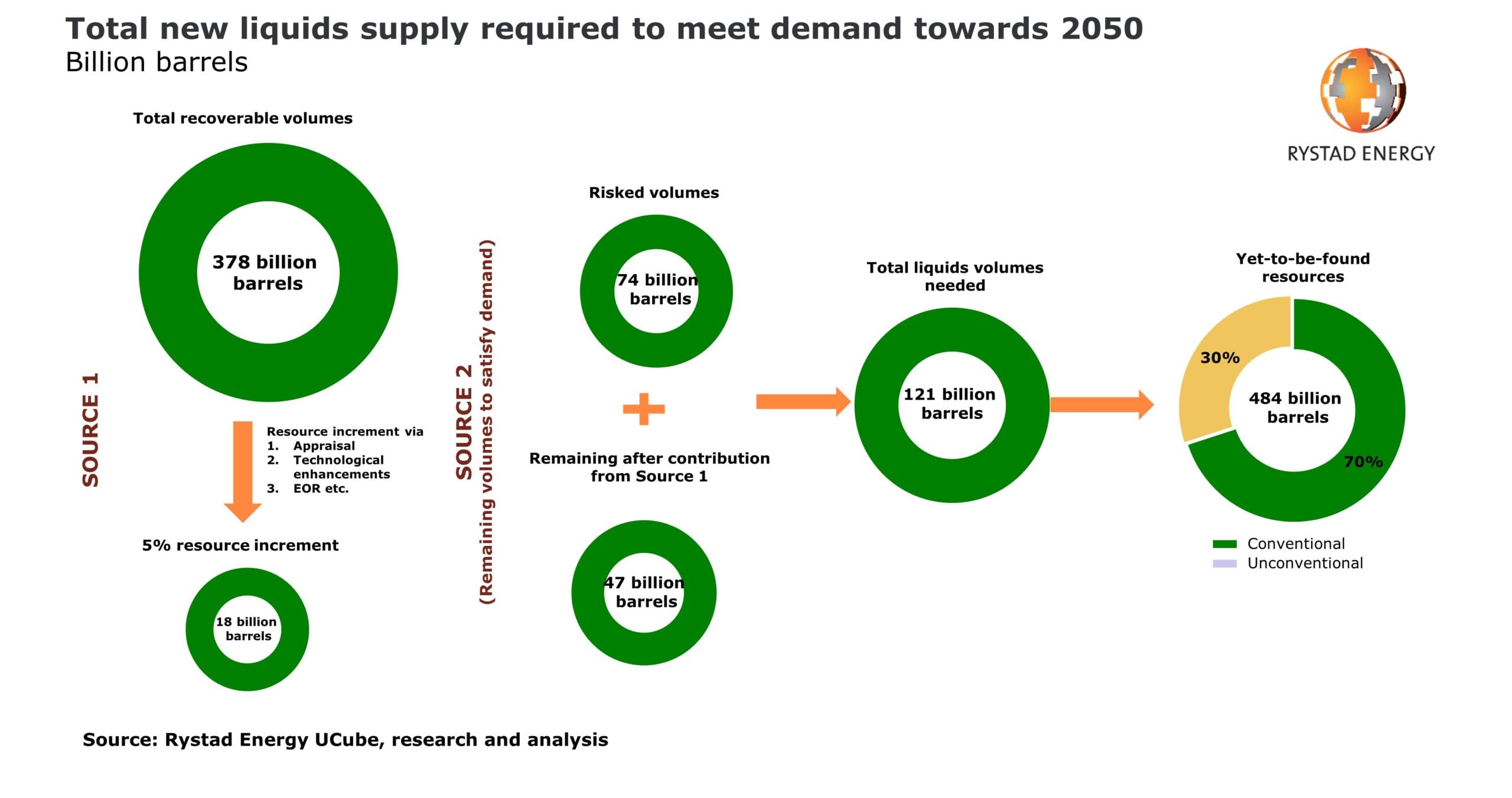The world is on track to run out of sufficient oil supplies to meet its needs through 2050, despite lower future demand due to the coronavirus pandemic and the accelerating energy transition – unless exploration speeds up significantly and capital expenditure of at least $3 trillion is put to the task, a bombshell report by Rystad Energy reveals.
To meet the global cumulative demand over the next 30 years, undeveloped and undiscovered resources totaling 313 billion barrels of oil need to be added to currently producing assets. Rystad Energy calculates that to match this requirement, exploration programs will have to discover a worthy-to-develop resource of 139 billion new barrels of liquids by 2050, an impossible task if this decade’s low exploration activity levels persist.
The target is high because not all existing discovered volumes are profitable to develop. In theory, the total undeveloped supply would amount to 248 billion barrels of oil between 2021 and 2050. However, Rystad Energy said when it dives deeper into these discoveries and look at their discovery decade and current status, it finds that about 74 billion barrels are highly unlikely to materialize and need to be replaced by new discoveries.
Looking at the global conventional exploration potential, there are two main sources for these new volumes: further appraisal of existing fields and resources, and new discoveries.
The first source includes projects in their early production stage, projects under development, and unrisked volumes in discovered assets. “We expect that some future exploration activity will lead to reservoir delineation and enhancement of resource estimates, while technological improvements and other secondary recovery techniques will also increase recoverable volumes,” Rystad Energy said.
Projects in the above-mentioned categories are currently forecast to contribute around 378 billion barrels of liquids supply between 2021 and 2050. If future exploration follows industry norms, it will enhance recoverable resources by around 5%, or 18 billion barrels, leaving a deficit of about 121 billion barrels to be unearthed through future exploration drilling in currently undiscovered areas – our second source of new supply.
Analyzing the discovery rates of the current decade and the latest trends, Rystad Energy expects that global conventional discovered liquid volumes could settle at around 4 billion barrels per year, with an average discovery size of around 40 million barrels. This means that explorers would need to announce at least 100 new conventional discoveries each year to reach the magic volume number needed to meet demand.
However, just like in the past, not all volumes discovered during this period will be developed and produced, and much of it may not be brought on stream to meet demand by 2050. The total discovered volumes will therefore have to be much higher than the required cumulative liquids supply.
To find an approximate volume number for new discoveries, Rystad Energy said it looked at variables such as the share of produced volumes from discoveries in the past three decades and the time taken from discovery to start-up. About 617 billion barrels of liquids have been found since 1990, and about 25% of these discovered volumes had been produced through 2020. Analogically, explorers would have to unearth about 484 billion barrels of new resource through 2050 to put the required 121 billion barrels of liquids to production over the next 30 years.
Unconventional exploration will also contribute to meet the required volumes – Rystad Energy expects around 30% of the deficit volumes between 2021 and 2050 to come from global unconventional plays. Consequently, conventional exploration drilling would need to unearth around 330 billion barrels of oil through 2050 to meet global demand.
The global exploration success ratio has dropped sharply, from about 72% in 2010 to 17% in 2020. As “easier” hydrocarbons are already discovered, it will become increasingly difficult to find new resources in mature areas, and a more stringent exploration approach means that only the top-ranked prospects will be drilled. Rystad Energy said it therefore expects to see an average success ratio of 15% to 20% through 2050. A 20% ratio requires around 500 wells to be drilled each year, or 650 wells at a 15% chance of success.
“We expect deepwater offshore areas to continue to dominate future new discovered volumes. More challenging drilling environments will push the average well cost to about $50 million, lifting the annual cost of exploration drilling to between $25 billion and $33 billion in at the above success rates,” the Norway based consultancy group said.
However, at the past decade’s pace and success rates with average annual discoveries of 4 billion barrels, it would take about 80 years to find the 330 billion barrels needed to cover the supply deficit for undiscovered resources. This would bring the cost of drilling to between $2 trillion and $2.6 trillion.
In addition to drilling, discovering these volumes will require spending on geological and geophysical studies, leasehold costs and signature bonuses to be paid for future lease rounds. Historically, the ratio of drilling to other exploration costs is 52:48. Furthermore, appraisal drilling needs to be carried out to get the 5% incremental volumes mentioned previously. This would require further spending of about $45 billion.
Altogether, Rystad Energy said it estimates that the cumulative exploration cost required to satisfy liquids supply from conventional sources could be between $3.8 trillion and $5 trillion through 2050. However, as these figures are based on historic assumptions, costs could be pushed down significantly – potentially to around $3 trillion – thanks to fast-tracking of discovered resources and some giant discoveries.

“The scope of exploration will have to expand significantly. Unless we see a momentous transition in the global energy mix sooner than currently expected, or a much faster development pace than the current norm, upstream players may have to more than double their conventional exploration efforts in order to meet global oil demand through 2050,” says Palzor Shenga, senior upstream analyst at Rystad Energy.




